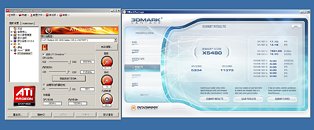Monday, March 23rd 2009

RV790 Reaches 1.00 GHz, Indicates Overclocked SKUs in the Making
Following our report of ASUS preparing an overclocked Radeon HD 4890 accelerator with clock speeds well above 900 MHz (core) and 1000 MHz (memory), the possibility has come to surface that AMD has carved out a new range of Radeon HD 4890 accelerators from the unusually high overclocking headroom the RV790 GPU has. The credit also goes to the reference-design PCB, which is known to possess some of the highest quality digital PWM components to handle power, and 4 GT/s GDDR5 memory, which is now known to have a good overclocking headroom.
It has surfaced on the forums of Chinese tech community PCInLife, that the RV790 rather effortlessly reached the 1 GHz mark, the slider-limit of Catalyst Control Center, sparking off fresh rumors that AMD partners may be creating a fresh niche of highly-overclocked cards shortly after Radeon HD 4890 comes to be. The overclocker reached speeds of 1 GHz (core) and 1125 MHz (4.50 GHz effective, memory). At the said speeds, the card was put through 3DMark Vantage with its eXtreme settings. It churned-out a score of X5480, which puts its performance somewhere between those of the GeForce GTX 280 and GeForce GTX 285. It should also be taken into account that the drivers RV790 users the world over have been using, are preliminary beta drivers. AMD plans to release Catalyst 9.4 with the release of Radeon HD 4890, which just may impact positively on the performance of the product.Factory-overclocked cards based on ATI Radeon have since now been a formality. Even cards with the iconic HIS IceQ TurboX branding, haven't been known to have high (~15~20%) increase in clock speeds. With this feat surfacing, it has been established that the RV790 holds the capability to reach some very high clock speeds. On course to the 1 GHz mark, the overclocker at PCInLife comfortably reached 925/1025 MHz (X5021) and 950/1075 MHz (X5202). It sounds plausible that these speeds could be the speeds factory-overclocked cards come at, with a branding system similar to what NVIDIA uses: a tier-1 (light overclock), tier-2 (moderate overclock), tier-3 (high overclock), and tier-4 (extreme overclock). At any rate, this is turning out to be an exciting fortnight for the high-end GPU industry.
Source:
PCInLife
It has surfaced on the forums of Chinese tech community PCInLife, that the RV790 rather effortlessly reached the 1 GHz mark, the slider-limit of Catalyst Control Center, sparking off fresh rumors that AMD partners may be creating a fresh niche of highly-overclocked cards shortly after Radeon HD 4890 comes to be. The overclocker reached speeds of 1 GHz (core) and 1125 MHz (4.50 GHz effective, memory). At the said speeds, the card was put through 3DMark Vantage with its eXtreme settings. It churned-out a score of X5480, which puts its performance somewhere between those of the GeForce GTX 280 and GeForce GTX 285. It should also be taken into account that the drivers RV790 users the world over have been using, are preliminary beta drivers. AMD plans to release Catalyst 9.4 with the release of Radeon HD 4890, which just may impact positively on the performance of the product.Factory-overclocked cards based on ATI Radeon have since now been a formality. Even cards with the iconic HIS IceQ TurboX branding, haven't been known to have high (~15~20%) increase in clock speeds. With this feat surfacing, it has been established that the RV790 holds the capability to reach some very high clock speeds. On course to the 1 GHz mark, the overclocker at PCInLife comfortably reached 925/1025 MHz (X5021) and 950/1075 MHz (X5202). It sounds plausible that these speeds could be the speeds factory-overclocked cards come at, with a branding system similar to what NVIDIA uses: a tier-1 (light overclock), tier-2 (moderate overclock), tier-3 (high overclock), and tier-4 (extreme overclock). At any rate, this is turning out to be an exciting fortnight for the high-end GPU industry.

103 Comments on RV790 Reaches 1.00 GHz, Indicates Overclocked SKUs in the Making
Crysis automatically adds AF the higher your settings and if you don't have a lot of vram the game will get choppy because the system ram gets filled up as well and then it gets even more choppy. While in warhead they have reduced the distance at which detail increases and thus better performance. When you look at console games and I noticed this with Cod:waw the game is incredibly detailed up close but far away and its looks like your back on the atari.
Here's the bottom line, and you can all argue until your heads fall off, there's nothing that won't make this true: Games that hit consoles first are optimized for that console, and by the time they get to PC (GTA4 for example) the publishers could care less about pleasing PC gamers because at that point, putting money into optimizing the engine for PC's isn't as profitable as simply releasing it at bare minimum requirements.
A console game will generally always need brute force to run smooth on a pc, and with the way the cpu's are in today's consoles, having quad core in these games is a must.